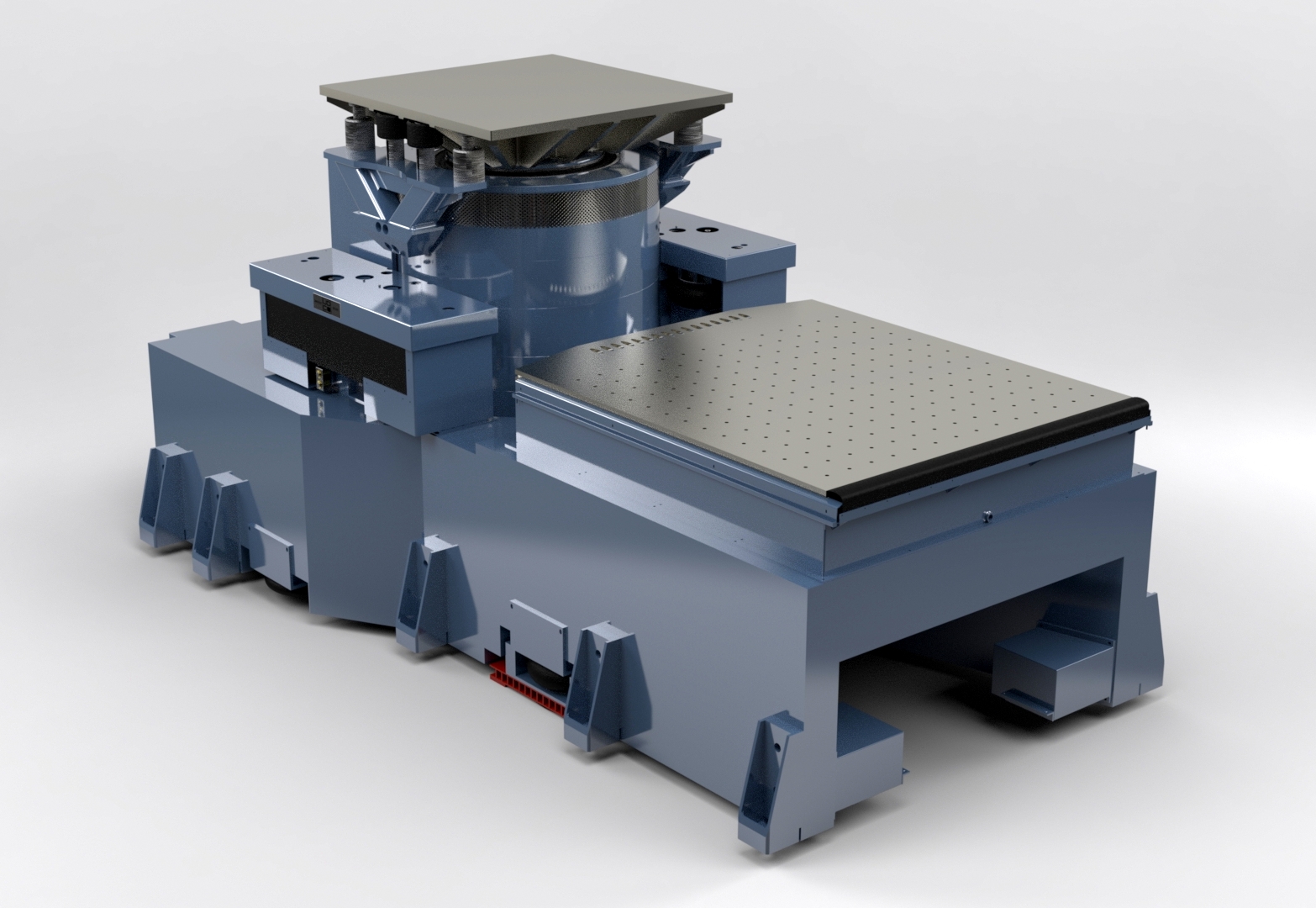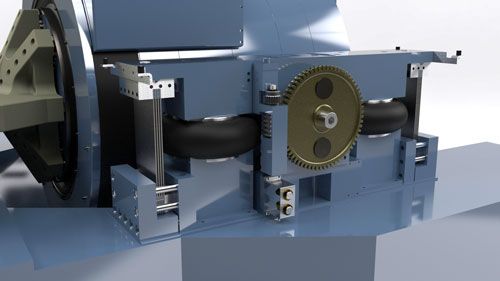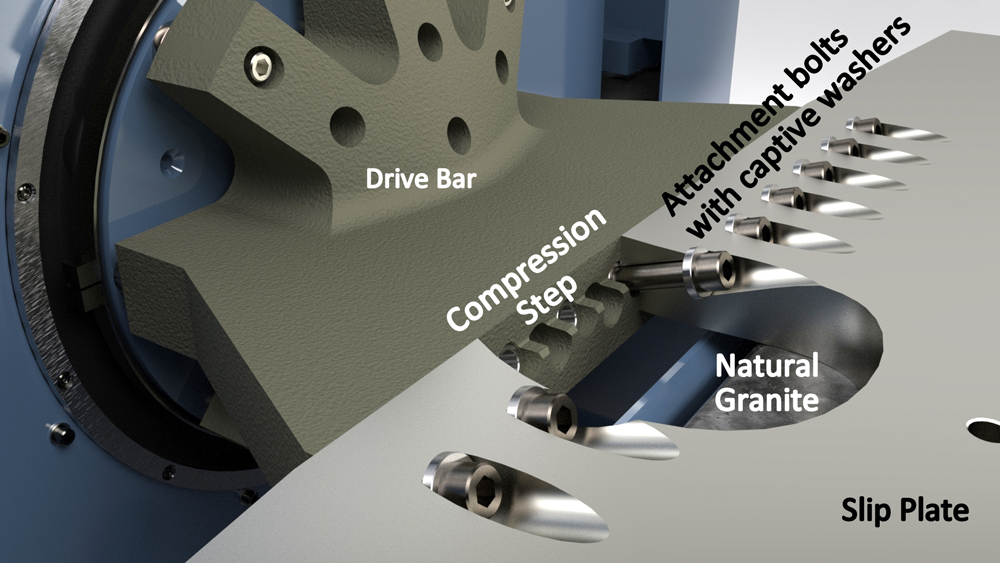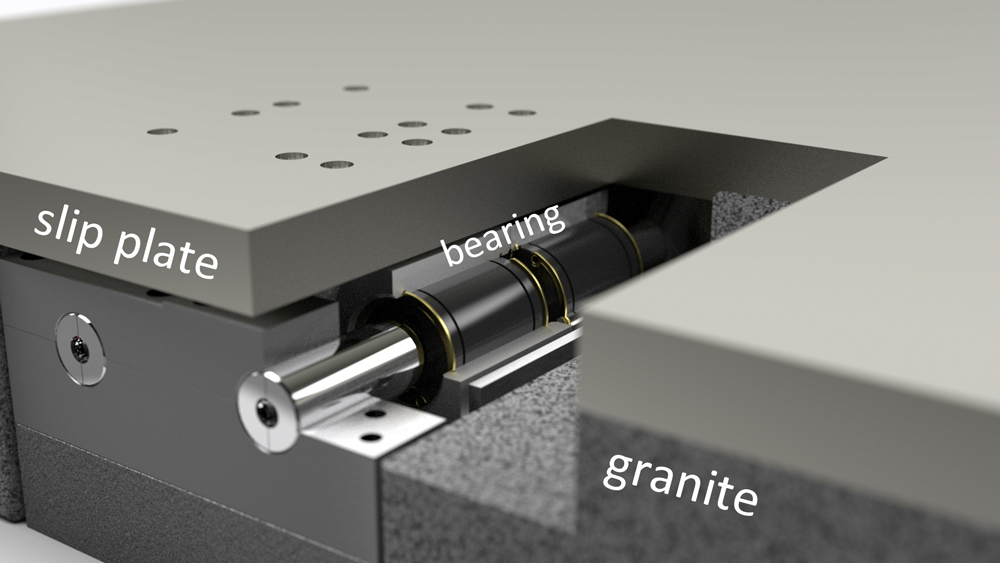CSTA Series Slip Table Assemblies
 Unholtz-Dickie introduced the Combined Slip Table Assembly (CSTA) in the late 1960s to meet the demand for positive mechanical alignment between the shaker and its companion horizontal slip table. The challenge was to achieve this positive, permanent alignment feature without requiring an expensive seismic mass in the vibration lab floor. The original CSTA design has been continuously improved over the years and has now become the industry standard for permanently aligned, integral reaction mass slip tables.
Unholtz-Dickie introduced the Combined Slip Table Assembly (CSTA) in the late 1960s to meet the demand for positive mechanical alignment between the shaker and its companion horizontal slip table. The challenge was to achieve this positive, permanent alignment feature without requiring an expensive seismic mass in the vibration lab floor. The original CSTA design has been continuously improved over the years and has now become the industry standard for permanently aligned, integral reaction mass slip tables.
The CSTA design utilizes a structural steel base with cross-bracing and stiffeners which provide a rigid platform for positive alignment between the shaker and slip table. Reinforced concrete is added to the base’s shell cavity, creating a robust and highly damped reaction mass. This substantial reaction mass is a key feature for obtaining full shaker stroke at low frequencies by minimizing shaker body motion with locked out trunnions. The base is deep-sectioned throughout its entire length and is designed with the combined shaker / reaction mass CG located close to the centerline of dynamic force (i.e. shaker centerline). These attributes minimize bending mode responses, and pitching excitation of the reaction mass when driving vertically. A further dividend of the massive base is excellent floor vibration isolation. Damped pneumatic isolators support the entire CSTA base, resulting in an isolation frequency below 3 Hz. This allows the CSTA to be installed on any standard industrial floor and relocated easily when necessary.
Permanent Factory Alignment
Alignment of the Shaker and Slip Table is performed at the UD factory, then rigidly locked and bolted to establish a permanent, easily converted vertical-to-horizontal changeover procedure. No feeler gage checks or tedious mechanical adjustments are required throughout the life of the machine.
Worm Gear Rotation
For convenience and safety, UD CSTA bases include a high ratio gear drive assembly for easy shaker rotation. A half-inch ratchet drive is provided to allow simple, one-man operation. The larger T4000, T5000 and T5500 shakers include a pneumatic ratchet.
Granite Bearing Support
Unholtz-Dickie uses only natural granite as the table support material. The thick granite slab transfers its mechanical stiffness to the magnesium slip plate through adhesion of the oil film acting over the entire granite surface area. Some competitors substitute lower cost “synthetic” granite for table support, which can exhibit chipping and peeling as test hours are accumulated, leading to possible slip plate scoring and waveform distortion. Natural granite eliminates these problems.
Vibration Isolation
R-Series, K-Series and T2000 Series Shakers
All R-Series, K-Series and T2000 Series shakers configured on CSTA Slip Table assemblies include trunnions that are rigidly bolted to the base. During both vertical and horizontal testing, the entire assembly "floats" on a set of four, damped airbag isolators, effectively isolating the entire assembly from the building structure. Vibration isolator frequencies of 3 Hz are typical, thereby eliminating the need for expensive building modifications. Air bag pressure is automatically controlled via integral pressure regulators, and an auto-base leveling system insures the entire base and DUT are kept level during testing.
T4000, T5000 and T5500 Series Shakers
 "Align-Lock" trunnion hardware is a standard feature on all large shaker CSTA's. During horizontal operation, heavy duty steel flexures oriented vertically (see photo) are enabled to allow horizontal translation of the shaker body without coupling the reaction forces into the CSTA base. Align-Lock is a user selectable operating mode that minimizes low frequency base motion for applications that don't require the full maximum stroke of the shaker. During vertical operation, trunnion mounted, damped air bags can be inflated to lift and support the shaker, and provide effective vibration isolation for tests that do not require the maximum shaker stroke. For maximum stroke, the trunnions can be locked out and the entire base isolated via floor air bags.
"Align-Lock" trunnion hardware is a standard feature on all large shaker CSTA's. During horizontal operation, heavy duty steel flexures oriented vertically (see photo) are enabled to allow horizontal translation of the shaker body without coupling the reaction forces into the CSTA base. Align-Lock is a user selectable operating mode that minimizes low frequency base motion for applications that don't require the full maximum stroke of the shaker. During vertical operation, trunnion mounted, damped air bags can be inflated to lift and support the shaker, and provide effective vibration isolation for tests that do not require the maximum shaker stroke. For maximum stroke, the trunnions can be locked out and the entire base isolated via floor air bags.
Cast Magnesium Driver Bar
A cast magnesium driver bar joins the shaker table and the magnesium slip plate. The cast driver bar provides a stronger, more reliable attachment than welded driver bars and eliminates inherent weaknesses associated with welding such as insufficient penetration, root cracks, blow holes, and heat effected zones.
Compression-Step Interface
 The Compression-Step design was first offered by Unholtz-Dickie. It provides a large distributed mating surface area, preloaded in compression, and demonstrates greater transmissibility between the shaker and slip plate than split ring and orthogonal designs. Angular orientation of the fasteners produces compression forces across all mating surfaces giving superior dynamic performance and makes the driver bar connection an operator-friendly procedure.
The Compression-Step design was first offered by Unholtz-Dickie. It provides a large distributed mating surface area, preloaded in compression, and demonstrates greater transmissibility between the shaker and slip plate than split ring and orthogonal designs. Angular orientation of the fasteners produces compression forces across all mating surfaces giving superior dynamic performance and makes the driver bar connection an operator-friendly procedure.
Constant Volume/Multi-Port Oil System
A constant volume multi-port hydraulic system is supplied as standard with the CSTA base and is easily accessible. This system provides oil to the slip plate/granite interface from underneath the granite support eliminating interference problems associated with designs where oil feed lines are external to the slip plate. The constant volume multi-port design ensures that a constant volume of oil is supplied at each feed site under the slip table and thus reduces the possibility of localized oil starvation even when the test package CG is located near the end of the plate away from the shaker.
Oilguard
Unholtz-Dickie has developed a new feature to solve the age old problem of having unwanted water and foreign particles from entering the slip table re-circulating oil. Contaminants increase oil replacement frequency, require additional maintenance and decrease reliability. Oilguard effectively covers all exposed areas, reducing the possibility of slip table oil contamination.
Guided Oil Film Table
The standard Guided Oil Film Table utilizes a center-groove element to support and guide the magnesium slip plate. Oil is dispersed through multiple ports in the granite slab by a low pressure, closed-loop pumping system. The lubricated granite provides a low friction slip surface for horizontal motion of the magnesium plate, with inherent pitch & roll restraint derived from oil film adhesion. Yaw restraint is controlled by a centerline guide element at the outboard end of the slip plate, and is supplemented by the shaker armature guidance system. These standard features provide for cost-effective horizontal axis operation to meet most general purpose testing applications.
Linear Guide Bearings
 For horizontal tests requiring higher off-axis restraint, CSTA Slip Tables can be equipped with Linear Bearings. These bearings are installed in cavities within the lubricated granite block but receive independent oil porting. The robust bearings are configured in tandem, on or alongside the centerline and are widely spaced front-to-rear for maximum pitch and yaw restraint. This location minimizes the risk of binding during combined environment (temp/vibe) testing, a common problem with Hydrostatic Bearing Tables. Two, four, eight and sixteen bearing (-2LB, -4LB, -8LB and -16LB) configurations are available, covering a wide range of payload and test level applications.
For horizontal tests requiring higher off-axis restraint, CSTA Slip Tables can be equipped with Linear Bearings. These bearings are installed in cavities within the lubricated granite block but receive independent oil porting. The robust bearings are configured in tandem, on or alongside the centerline and are widely spaced front-to-rear for maximum pitch and yaw restraint. This location minimizes the risk of binding during combined environment (temp/vibe) testing, a common problem with Hydrostatic Bearing Tables. Two, four, eight and sixteen bearing (-2LB, -4LB, -8LB and -16LB) configurations are available, covering a wide range of payload and test level applications.
